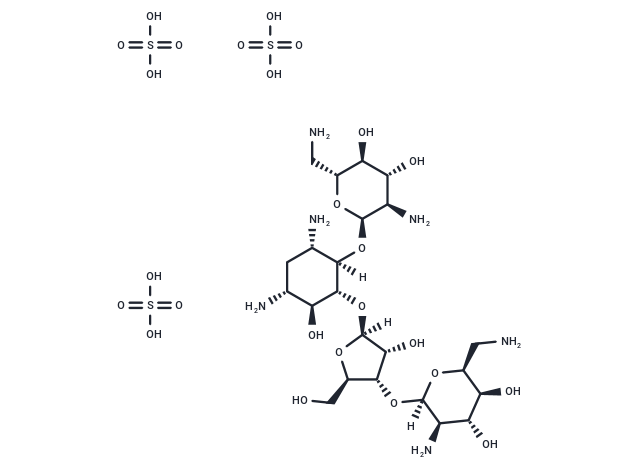Shopping Cart
- Remove All
 Your shopping cart is currently empty
Your shopping cart is currently empty

Framycetin sulfate (Neomycin Sulphate B) belongs to aminoglycoside class of antibiotics that contain two or more aminosugars connected by glycosidic bonds.

| Pack Size | Price | Availability | Quantity |
|---|---|---|---|
| 25 mg | $39 | In Stock | |
| 50 mg | $64 | In Stock | |
| 100 mg | $89 | In Stock | |
| 200 mg | $128 | In Stock | |
| 500 mg | $219 | In Stock | |
| 1 mL x 10 mM (in H2O) | $39 | In Stock |
| Description | Framycetin sulfate (Neomycin Sulphate B) belongs to aminoglycoside class of antibiotics that contain two or more aminosugars connected by glycosidic bonds. |
| Targets&IC50 | Hammerhead ribozyme:13.5 μM (Ki), RNase P cleavage activity:35 μM (Ki) |
| Alias | Neomycin Sulphate B, Framycetin sulphate |
| Molecular Weight | 712.22 |
| Formula | C23H48N6O17S |
| Cas No. | 4146-30-9 |
| Smiles | OS(O)(=O)=O.OS(O)(=O)=O.OS(O)(=O)=O.[H][C@@]1(O[C@@H]2[C@@H](O)[C@H](N)C[C@H](N)[C@@]2([H])O[C@H]2O[C@H](CN)[C@@H](O)[C@H](O)[C@H]2N)O[C@H](CO)[C@@H](O[C@@]2([H])O[C@@H](CN)[C@@H](O)[C@H](O)[C@H]2N)[C@H]1O |
| Relative Density. | no data available |
| Storage | store at low temperature | Powder: -20°C for 3 years | In solvent: -80°C for 1 year | Shipping with blue ice. | |||||||||||||||||||||||||||||||||||
| Solubility Information | H2O: 125 mg/mL (175.51 mM), Sonication is recommended. DMSO: Insoluble | |||||||||||||||||||||||||||||||||||
Solution Preparation Table | ||||||||||||||||||||||||||||||||||||
H2O
| ||||||||||||||||||||||||||||||||||||

Copyright © 2015-2025 TargetMol Chemicals Inc. All Rights Reserved.